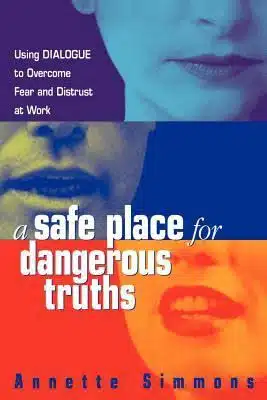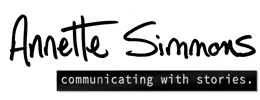Since most of us have gotten into trouble for telling the truth at one time or another “we too quickly conclude that telling the truth is a bad idea.

A welcome guide to creating a workplace where people can talk frankly without fear for their jobs…even if it means dredging up deep-buried conflicts or calling attention to their own shortcomings. A behavioral science consultant, Annette Simmons provides the key through the formal process of “dialogue.” More than ordinary conversation, this specific group give-and-take technique opens minds, eases, anxiety, and encourages straightforward truth-telling. Simmons firmly believes: “When a group learns how to discuss the un-discussable, they learn how to solve the unsolvable.” Packed with step-by-step “how-to” guidelines and helpful scenarios, this book gives readers the critical insights and skills to facilitate the process and bring the power of “dialogue” to any situation. Facilitators will also find pointers on asking the right questions to get a dialogue going, using story telling to bring an issue to life, and knowing when to step back and let the group go it alone. Simmons even provides a sample script for a dialogue session. Lively, down-to-earth, and encouraging, A Safe Place for Dangerous Truths charts a promising path toward renewed authenticity, openness, trust, and creative daring among people who work together.
In one recent survey, 93% of people admitted to lying regularly at work. Maybe they are scared of losing their jobs. Maybe they don’t trust their colleagues or don’t want to “rock the boat.” As Simmons says, “When people in a group improve their ability to talk to each other they spontaneously improve their ability to work together. When they learn how to discuss the undiscussable they learn how to solve the unsolvable.”
Since most of us have gotten into trouble for telling the truth at one time or another “we too quickly conclude that telling the truth is a bad idea. We decide to stay beneath the radar and either end up bitter and resentful unexpectedly explode and cause a scene. We need a third alternative.”
A Safe Place for Dangerous Truth: Using Dialogue to Overcome Fear and Distrust describes an alternative where a workgroup takes time out on a regular basis to:
a.) slow things down and temporarily tolerate the frustration of listening to people “who don’t know what they are talking about”
b.) suspend the norm of “let someone else say it” long enough so that someone names the problem(s)
Annette points out that in this world where “being busy is such a status symbol,” we must carve out a time for refection and dialogue. “People looking for the ‘right time’ to discuss a dangerous truth never find it because the workplace never slows down enough for people to calmly deal with dangerous truths.” This book describes an alternative that routinely introduces ‘thinking time’ back into the workplace.
A few reviews from Amazon:
“Dialogue is a difficult and potentially fear inducing process. The author admits all that and gives the reader the background and a process to facilitate and engage in dialogue. The book is easy-to-read, free of unnecessarily confusing jargon, and full of good illustrative anecdotes. The author recommends some unorthodox facilitative roles based on her experience (some of which I had thought of before I read the book, but was afraid to try out). I found myself jumping from section to section to follow my interest—this was not a linear ead for me. The appendix on how to get dialogue started with a group is also helpful.”
“This is an excellent “how to” book, that deals with a nebulous subject, dialogue. It not only endorses and explains the need for dialogue, but goes way beyond helping middle management and leadership understand the important steps that must be taken if an organization is going to really attempt to change the culture and create a new atmosphere in which dialogue just might happen!”
“Enjoy!”




